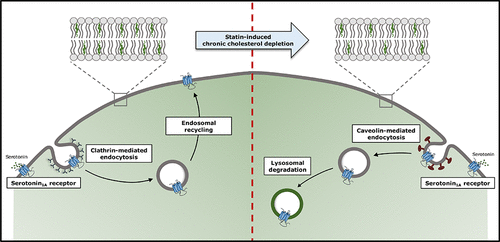当前位置:
X-MOL 学术
›
ACS Chem. Neurosci.
›
论文详情
Our official English website, www.x-mol.net, welcomes your
feedback! (Note: you will need to create a separate account there.)
Statin-Induced Chronic Cholesterol Depletion Switches GPCR Endocytosis and Trafficking: Insights from the Serotonin1A Receptor.
ACS Chemical Neuroscience ( IF 4.1 ) Pub Date : 2020-01-09 , DOI: 10.1021/acschemneuro.9b00659 G Aditya Kumar 1 , Amitabha Chattopadhyay 1
ACS Chemical Neuroscience ( IF 4.1 ) Pub Date : 2020-01-09 , DOI: 10.1021/acschemneuro.9b00659 G Aditya Kumar 1 , Amitabha Chattopadhyay 1
Affiliation

|
Endocytosis is a key regulatory mechanism adopted by G protein-coupled receptors (GPCRs) to modulate downstream signaling responses within a stringent spatiotemporal regime. Although the role of membrane lipids has been extensively studied in the context of the function, organization, and dynamics of GPCRs, their role in receptor endocytosis remains largely unexplored. Cholesterol, the predominant sterol in higher eukaryotes, plays a crucial role in maintaining the structure and organization of cell membranes and is involved in essential cellular processes in health and disease. The serotonin1A receptor is a representative GPCR involved in neuronal development and in neuropsychiatric disorders such as anxiety and depression. We recently combined quantitative flow cytometric and confocal microscopic approaches to demonstrate that the serotonin1A receptor undergoes clathrin-mediated endocytosis upon agonist stimulation and subsequently traffics along the endosomal recycling pathway. In this work, we show that statin-induced chronic cholesterol depletion switches the endocytic pathway of the serotonin1A receptor from clathrin- to caveolin-mediated endocytosis. Interestingly, under these conditions, a significant proportion of endocytosed receptors is rerouted toward lysosomal degradation. To the best of our knowledge, these results constitute one of the first comprehensive reports on the role of membrane cholesterol in GPCR endocytosis and trafficking. These results are significant in our overall understanding of the modulatory effects of membrane lipids on GPCR endocytosis and trafficking and could provide novel insight in developing therapeutic interventions against neuropsychiatric disorders such as depression.
中文翻译:

他汀类药物诱导的慢性胆固醇耗竭开关GPCR内吞和贩运:血清素1A受体的见解。
内吞作用是G蛋白偶联受体(GPCR)所采用的一种关键调节机制,可在严格的时空范围内调节下游信号传导反应。尽管在GPCR的功能,组织和动力学方面已广泛研究了膜脂质的作用,但在受体内吞作用中的作用仍未得到充分研究。胆固醇是高等真核生物中的主要固醇,在维持细胞膜的结构和组织方面起着至关重要的作用,并且参与了健康和疾病的基本细胞过程。血清素1A受体是一种代表性的GPCR,参与神经元发育和神经精神疾病,如焦虑和抑郁。我们最近结合了定量流式细胞术和共聚焦显微镜方法,以证明5-羟色胺1A受体在激动剂刺激下会发生网格蛋白介导的内吞作用,并随后沿着内体再循环途径运输。在这项工作中,我们表明他汀类药物诱导的慢性胆固醇耗竭将5-羟色胺1A受体的胞吞途径从网格蛋白转换为小窝蛋白介导的内吞作用。有趣的是,在这些条件下,很大比例的内吞受体被重新导向溶酶体降解。据我们所知,这些结果构成了膜胆固醇在GPCR内吞和运输中作用的首批综合报道之一。
更新日期:2020-01-10
中文翻译:

他汀类药物诱导的慢性胆固醇耗竭开关GPCR内吞和贩运:血清素1A受体的见解。
内吞作用是G蛋白偶联受体(GPCR)所采用的一种关键调节机制,可在严格的时空范围内调节下游信号传导反应。尽管在GPCR的功能,组织和动力学方面已广泛研究了膜脂质的作用,但在受体内吞作用中的作用仍未得到充分研究。胆固醇是高等真核生物中的主要固醇,在维持细胞膜的结构和组织方面起着至关重要的作用,并且参与了健康和疾病的基本细胞过程。血清素1A受体是一种代表性的GPCR,参与神经元发育和神经精神疾病,如焦虑和抑郁。我们最近结合了定量流式细胞术和共聚焦显微镜方法,以证明5-羟色胺1A受体在激动剂刺激下会发生网格蛋白介导的内吞作用,并随后沿着内体再循环途径运输。在这项工作中,我们表明他汀类药物诱导的慢性胆固醇耗竭将5-羟色胺1A受体的胞吞途径从网格蛋白转换为小窝蛋白介导的内吞作用。有趣的是,在这些条件下,很大比例的内吞受体被重新导向溶酶体降解。据我们所知,这些结果构成了膜胆固醇在GPCR内吞和运输中作用的首批综合报道之一。










































 京公网安备 11010802027423号
京公网安备 11010802027423号